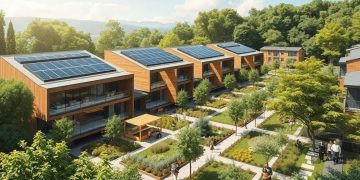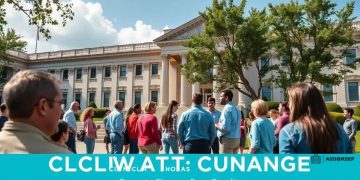ESG-linked loans for innovative community housing

ESG-linked loans support sustainable community housing projects by providing financing based on environmental, social, and governance performance, enhancing development and social impact.
ESG-linked loans for community affordable housing projects are gaining traction as an innovative financing option. But how do they truly impact community development and sustainability? Let’s dive into this transformative approach.
Understanding ESG-linked loans
Understanding ESG-linked loans is essential for communities aiming to enhance affordable housing projects. These loans are designed to provide financing based on the borrower’s performance in environmental, social, and governance (ESG) criteria. This financing approach encourages borrowers to adopt sustainable practices.
The Importance of ESG Criteria
ESG criteria serve as a framework to assess how an organization manages risks and opportunities related to these three factors. Investors and lenders are increasingly prioritizing these metrics in decision-making processes.
Key Benefits of ESG-linked Loans
- Lower interest rates for projects meeting ESG goals.
- Increased access to capital for sustainable development.
- Enhanced reputation and attractiveness to investors.
Additionally, ESG-linked loans stimulate positive change in communities. They not only provide financial support but also promote responsible practices that can lead to long-term social improvements. By securing these loans, developers can invest in energy-efficient buildings, thereby reducing overall environmental impact.
Moreover, the integration of ESG considerations into loan agreements fosters accountability. Borrowers must continually monitor their performance against agreed-upon targets. This creates an ongoing relationship between lenders and borrowers, focused on sustainability and responsibility.
How ESG Factors Influence Housing Projects
ESG factors influence housing projects significantly. For instance, developers must consider the environmental impact of their projects. They can achieve this by utilizing renewable materials, implementing energy-efficient designs, and promoting green spaces.
Challenges in Adopting ESG-linked Loans
Despite their benefits, challenges exist in adopting ESG-linked loans. Some organizations may find it difficult to meet stringent ESG criteria or may lack knowledge on how to implement such practices effectively. Education and support are vital to overcoming these hurdles.
How ESG factors influence housing projects
How ESG factors influence housing projects is a crucial consideration for developers today. These factors play a significant role in shaping the outcomes of projects in communities, focusing on sustainability and social responsibility.
Environmental Impact
One of the most significant aspects of the ESG framework is its emphasis on environmental impact. Housing projects must consider energy efficiency and the use of sustainable materials. These projects not only reduce carbon footprints but also appeal to eco-conscious buyers.
Social Responsibility
Incorporating social factors is equally important. Developers should focus on community engagement and the needs of residents. Understanding what families want in affordable housing can lead to more successful projects.
- Creating community spaces for interaction.
- Ensuring accessibility for all residents.
- Designing with input from local stakeholders.
In addition, the governance aspect of ESG involves making sure that projects are managed ethically. Transparency in operations builds trust with the community and encourages more participation from local residents. Developers should also establish clear practices for involving community members throughout the building process.
Furthermore, a strong governance structure contributes to long-term sustainability. Proper management means projects can adapt to changing community needs, ensuring that housing remains relevant over time. This adaptability is vital in a rapidly evolving urban landscape.
Long-Term Benefits of ESG Compliance
Adopting ESG factors leads to several long-term benefits. Besides improving a project’s marketability, it can attract investors who prioritize sustainability. This alignment with ESG principles can result in increased funding for future developments.
Benefits of ESG-linked financing for communities

The benefits of ESG-linked financing for communities extend far beyond mere financial support. This innovative funding mechanism encourages sustainable practices while fostering social well-being within neighborhoods.
Enhancing Community Development
One of the primary advantages is the boost to local development projects. By focusing on environmental, social, and governance factors, these loans help ensure that investments lead to positive community outcomes. This can include the construction of energy-efficient homes and the creation of public spaces.
Attracting Investment
Moreover, ESG-linked financing attracts investors who prioritize sustainability. These investors are often more willing to provide capital to projects that demonstrate a commitment to responsible practices. This influx of funds can lead to more comprehensive development plans that benefit the entire community.
- Improved access to funding sources.
- Increased market appeal for new developments.
- Long-term financial savings through sustainable practices.
Furthermore, communities stand to gain from the social benefits inherent in ESG-linked projects. Such financing often mandates community engagement, ensuring that residents have a voice in the development process. This inclusion fosters trust and strengthens community bonds.
Additionally, ESG compliance can lead to a better quality of life for residents. Sustainable practices can reduce utility costs, improve air and water quality, and create healthier living environments. All these elements contribute to more vibrant, livable communities.
Long-Term Economic Stability
Finally, ESG-linked financing promotes long-term economic stability. Projects supported by these loans are typically designed with resilience in mind, allowing them to withstand economic fluctuations. This stability benefits both current residents and future generations.
Challenges in securing ESG-linked loans
Securing ESG-linked loans presents several challenges that can hinder the progress of community housing projects. Understanding these obstacles is crucial for developers looking to leverage this form of financing.
Complexity of ESG Criteria
A major challenge lies in the complexity of ESG criteria itself. Different lenders may have varying requirements, making it hard for borrowers to understand what is needed for approval. Developers need to be well-informed about these criteria to navigate effectively.
High Documentation Requirements
Another barrier is the extensive documentation required to prove ESG compliance. This often involves detailed reports on environmental impact, social responsibility, and governance practices. Gathering this information can be time-consuming and costly. Furthermore, smaller organizations may struggle to allocate the necessary resources for this process, creating disparities in access to financing.
- Difficulty in measuring ESG performance.
- Limited knowledge about ESG standards among stakeholders.
- Higher upfront costs associated with compliance initiatives.
Additionally, many lenders may prioritize established developers with previous records in ESG-related projects, potentially sidelining new or smaller entities. This can lead to a lack of diversity in the types of projects that receive funding.
Another significant challenge is market volatility. Economic uncertainties can affect lenders’ willingness to fund new projects, especially in the housing sector. A shifting market landscape can lead to tightened lending standards, making it harder for projects to qualify for funds.
Balancing Profit and Purpose
Lastly, there is often a tension between profit-driven motives and the broader social objectives of ESG-linked loans. While many developers want to succeed financially, they must also align their goals with community well-being. This balance can be tricky to achieve, leading to potential conflicts in project execution.
Case studies of successful projects
Case studies of successful projects using ESG-linked loans highlight how financing can transform communities. These examples demonstrate the positive impact of aligning financial objectives with social and environmental goals.
Project 1: Green Housing in Urban Areas
One notable case is a green housing development in an urban area. This project focused on sustainability and social inclusion. By securing an ESG-linked loan, the developers could implement energy-efficient designs and use renewable materials. These efforts resulted in lower utility costs for residents and a smaller carbon footprint for the community.
Project 2: Revitalization of a Historic Neighborhood
Another successful project involved revitalizing a historic neighborhood. By utilizing ESG financing, developers engaged local stakeholders and ensured that the community’s needs were prioritized. This project not only restored buildings but also created public spaces, improving overall livability.
- Increased access to affordable housing.
- Enhanced community amenities and infrastructure.
- Promotion of local businesses and job opportunities.
Moreover, the project demonstrated how ESG-linked loans could bring together various stakeholders, including local governments, non-profits, and community residents. This collaboration was essential for the project’s success, showcasing a model that can be replicated in other areas.
Project 3: Sustainable Community Center
A sustainable community center serves as another excellent example. This facility was developed to provide educational resources and recreational activities, all while adhering to ESG principles. The use of ESG-linked financing allowed for the incorporation of solar panels and green roofs, making the center not only functional but also environmentally friendly.
These case studies demonstrate that with the right approach and financing, communities can achieve their goals of sustainability, social responsibility, and economic growth. They showcase the importance of integrating ESG factors into project planning and execution, leading to beneficial outcomes for all stakeholders involved.
ESG-linked loans present a valuable opportunity for communities seeking sustainable development. By understanding and overcoming challenges related to these loans, developers can create projects that not only benefit investors but also deliver significant social and environmental impacts. Successful case studies show how combining financial goals with ESG principles leads to thriving neighborhoods. As more projects focus on these factors, communities will grow stronger, more inclusive, and resilient for future generations. Taking steps towards integrating ESG factors is essential in achieving a better tomorrow for the people and the planet.
FAQ – Frequently Asked Questions about ESG-Linked Loans for Community Housing
What are ESG-linked loans?
ESG-linked loans are financing options tied to a borrower’s performance on environmental, social, and governance criteria, promoting sustainable development.
How can ESG-linked loans benefit communities?
They can enhance community development, improve access to funding, and encourage investment in socially responsible projects that benefit residents.
What challenges do developers face when securing ESG-linked loans?
Developers may encounter complex criteria, high documentation requirements, and market volatility, making it challenging to qualify for such loans.
Can you provide examples of successful projects using ESG-linked loans?
Successful projects include urban green housing developments, revitalization of historic neighborhoods, and sustainable community centers, all showcasing positive community impacts.





